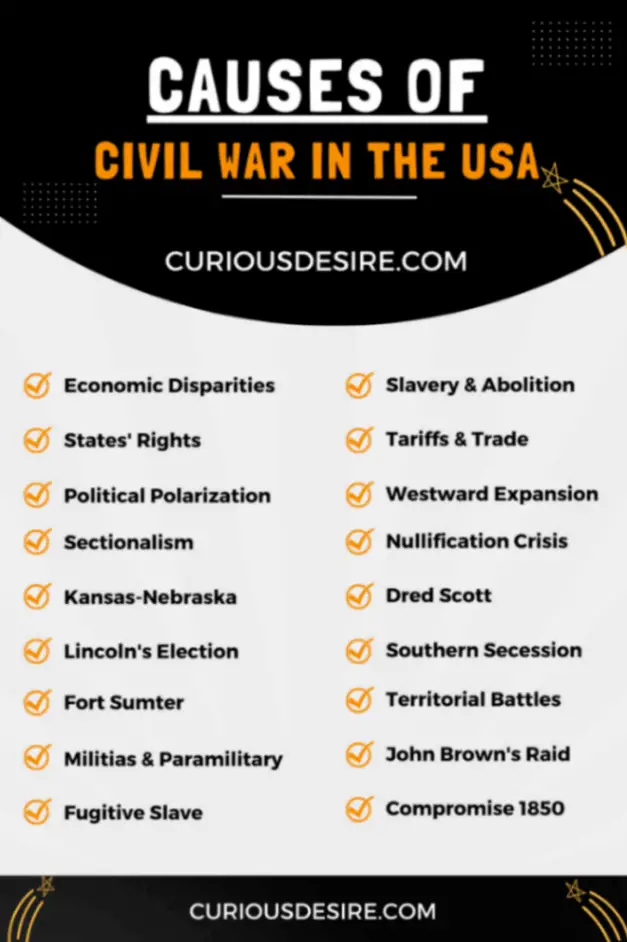The Civil War in the United States of America (USA), which took place from 1861 to 1865, was a defining moment in American history.
It was a conflict between the Northern states, known as the Union, and the Southern states, known as the Confederacy, over various political, economic, social, and cultural issues.
At its core, the Civil War was a struggle over the future of slavery in America, but it was also influenced by other factors. The outcome of the war had profound and lasting effects on the nation, shaping its trajectory for decades to come.
In this article, we will explore the 20 causes of the Civil War, ranging from economic disparities and the role of militias to religious and moral arguments, and examine their impact on the course of American history.
Through understanding these causes, we can gain insights into the complex dynamics that led to one of the most significant conflicts in American history and appreciate the lasting legacies it left behind.
Here are the 5 common causes of civil war in the USA:
- Economic Disparities
- Slavery and Abolitionist Movements
- States’ Rights vs. Federal Authority
- Political Polarization
- Westward Expansion and Manifest Destiny
1. Economic Disparities
Economic disparities played a significant role in causing the Civil War in the USA because they deepened the divide between the Northern and Southern states.
One example is the stark contrast between the agrarian economy of the South, reliant on slave labor for cotton production, and the industrialized economy of the North.
The North’s economy was expanding rapidly due to industrialization, while the South’s economy stagnated, leading to feelings of resentment and competition.
This economic gap heightened tensions over issues such as taxation, tariffs, and trade policies. The Southern states felt economically marginalized and feared that Northern dominance would threaten their way of life.
This divide ultimately fueled secessionist sentiments among Southern states, leading to the outbreak of the Civil War.
The outcome of this economic disparity was a devastating conflict that resulted in immense loss of life, destruction of property, and profound social and political changes in the United States.
2. Slavery and Abolitionist Movements
The issue of slavery was a fundamental cause of the Civil War in the USA, as it deeply divided the nation along moral, economic, and political lines.
The Southern states relied heavily on slave labor for their agricultural economy, particularly for cotton production.
The abolitionist movements, primarily in the North, sought to eradicate slavery based on moral principles, leading to intense debates and conflicts.
One significant historical event highlighting this tension was the Dred Scott Decision of 1857, where the Supreme Court ruled that slaves were not citizens and had no rights, further fueling abolitionist sentiments.
The effects of the slavery debate were profound, as it widened the gap between the North and South, ultimately contributing to the secession of Southern states and the outbreak of the Civil War.
3. States’ Rights vs. Federal Authority
The conflict over states’ rights versus federal authority was another critical factor leading to the Civil War.
Southern states argued for states’ rights to decide issues such as slavery within their borders, while the federal government sought to maintain its authority and unity over all states.
An example of this tension was the Nullification Crisis of 1832, when South Carolina attempted to nullify federal tariffs, asserting its right to reject federal laws.
This clash between state autonomy and federal power exacerbated sectional divisions and ultimately contributed to the outbreak of war.
The outcome of this struggle reshaped the balance of power between state and federal governments, solidifying federal authority over states’ rights.
4. Tariffs and Trade Policies
Tariffs and trade policies also played a significant role in exacerbating tensions between the North and South, contributing to the onset of the Civil War.
The Northern states favored protective tariffs to promote their industrial economy, while the Southern states, heavily reliant on agricultural exports, opposed tariffs that increased the cost of imported goods.
The Tariff of Abominations in 1828 sparked outrage in the South, leading to the Nullification Crisis and further straining relations between the regions.
These economic disputes highlighted the diverging interests of the North and South and reinforced the perception of economic exploitation by the federal government.
Ultimately, these conflicts over tariffs and trade policies deepened the divide between the Northern and Southern states, contributing to the outbreak of hostilities during the Civil War.
5. Political Polarization
Political polarization, where differing ideologies sharply divided Northern and Southern factions, was a significant cause of the Civil War in the USA.
The Democratic Party in the South and the emerging Republican Party in the North clashed vehemently over contentious issues such as slavery and states’ rights.
For instance, the election of Abraham Lincoln in 1860 heightened tensions, prompting Southern states to secede to protect their interests.
This polarization hindered constructive dialogue and compromise, ultimately escalating tensions and leading to the outbreak of hostilities.
The consequences were profound, as the Civil War resulted in immense loss of life, widespread devastation, and lasting social and political changes in America.
6. Westward Expansion and Manifest Destiny
The relentless drive for westward expansion, fueled by the notion of Manifest Destiny, contributed significantly to the causes of the Civil War.
As the United States expanded its territory, debates over the extension of slavery into newly acquired lands intensified.
For instance, the annexation of Texas and the Mexican-American War heightened tensions, as conflicting interests emerged regarding the expansion of slavery.
The belief in Manifest Destiny, the idea that Americans were destined to expand across the continent, exacerbated divisions between Northern and Southern states, as each region sought to promote its economic and social interests in the newly acquired territories.
This expansionist fervor deepened the divide between the North and South, setting the stage for the eruption of conflict.
7. Sectionalism: North vs. South Divide
Sectionalism, characterized by the growing divide between Northern and Southern states, was a fundamental catalyst for the Civil War.
Economic, social, and political disparities between the regions intensified over time, particularly concerning issues such as slavery and states’ rights.
The South’s agrarian economy, heavily dependent on slave labor, clashed with the North’s industrial economy and anti-slavery sentiments.
This sectional divide, exemplified by the contrasting priorities and values of each region, fueled animosity and contributed to the outbreak of war.
8. Nullification Crisis
The Nullification Crisis of 1832 marked a critical point in the escalating tensions between federal authority and states’ rights, laying the groundwork for the Civil War.
South Carolina’s attempt to nullify federal tariffs highlighted the state’s assertion of its right to reject federal laws it deemed unconstitutional.
While the crisis was temporarily resolved through compromise, it revealed deep-seated disagreements over the balance of power between the federal government and individual states, exacerbating the rift between North and South.
9. Kansas-Nebraska Act and Bleeding Kansas
The passage of the Kansas-Nebraska Act in 1854 and the subsequent violence in “Bleeding Kansas” exemplified the bitter struggle over the expansion of slavery into new territories.
This act repealed the Missouri Compromise of 1820, allowing settlers in the Kansas and Nebraska territories to decide the issue of slavery through popular sovereignty.
The resulting conflict between pro-slavery and anti-slavery settlers in Kansas erupted into violence, showcasing the failure of political compromise and the increasing radicalization and polarization that ultimately led to the outbreak of the Civil War.
10. Dred Scott Decision
The Dred Scott Decision of 1857 significantly contributed to the causes of the Civil War by deepening the divide over the issue of slavery in the United States.
The Supreme Court ruling denied Dred Scott, a slave, his freedom despite living in free territories, declaring that African Americans could not be citizens and had no rights under the Constitution.
This decision exacerbated tensions between the North and South, as it effectively invalidated the Missouri Compromise of 1820 and heightened fears among abolitionists that slavery could spread unchecked into all territories.
The ruling also sparked outrage among Northerners who saw it as evidence of Southern dominance in the federal government and the judiciary.
Consequently, the Dred Scott Decision fueled the growing abolitionist movement and galvanized anti-slavery sentiment in the North, further polarizing the nation and contributing to the eventual outbreak of the Civil War.
11. Election of Abraham Lincoln
Abraham Lincoln’s election as president in 1860 stirred up deep-seated fears among Southern states.
Lincoln’s Republican Party stood firmly against the expansion of slavery into new territories, which threatened the economic and social structure of the South.
Southern leaders convinced that Lincoln’s presidency would jeopardize their interests, viewed secession as the only means to safeguard their way of life.
For instance, South Carolina, one of the first states to secede, cited Lincoln’s election as a primary reason for its decision, expressing concern over the potential loss of states’ rights and the protection of slavery.
12. The Secession of Southern States
The secession of Southern states following Lincoln’s election exacerbated the already strained relationship between North and South.
By early 1861, seven states had seceded from the Union, forming the Confederate States of America.
The seceding states believed that withdrawing from the Union was necessary to preserve their sovereignty and uphold the institution of slavery.
Mississippi’s declaration of secession explicitly stated that the preservation of slavery was a central motivation. The secession of these states further polarized the nation and set the stage for armed conflict.
13. Fort Sumter Attack
The attack on Fort Sumter, a federal fort in South Carolina, marked a critical turning point that pushed the nation into war.
When President Lincoln attempted to send supplies to the fort in April 1861, Confederate forces, viewing the presence of Union troops in Confederate territory as an act of aggression, bombarded the fort, forcing its surrender.
This act of rebellion against federal authority galvanized Northern sentiment and unified support for the Union cause.
The attack on Fort Sumter served as a rallying cry for both sides, intensifying hostilities and solidifying the nation’s path toward war.
14. Battle over Territories like Texas and California
The battle over territories like Texas and California highlighted the nation’s deep divisions over the expansion of slavery.
For instance, the Compromise of 1850 attempted to address these disputes by admitting California as a free state and allowing popular sovereignty in other territories.
However, conflicts persisted, particularly in Kansas and Nebraska, where violent clashes erupted between pro-slavery and anti-slavery settlers.
The infamous “Bleeding Kansas” saw brutal confrontations between factions, highlighting the irreconcilable differences between North and South.
These territorial disputes, fueled by competing visions for the nation’s future, contributed significantly to the outbreak of the Civil War.
15. Role of Militias and Paramilitary Groups
Militias and paramilitary groups played a significant role in escalating tensions that led to the Civil War.
These groups, often formed along regional lines, contributed to the growing militarization of society and the normalization of violence as a means to achieve political goals.
For instance, in the years leading up to the war, paramilitary groups such as the “Border Ruffians” in Kansas engaged in violent confrontations over the expansion of slavery, further polarizing the nation and eroding trust in peaceful resolutions to conflicts.
These groups acted outside the realm of official government control, exacerbating the breakdown of law and order and contributing to a sense of lawlessness and chaos.
16. John Brown’s Raid on Harpers Ferry
John Brown’s raid on Harpers Ferry in 1859 exemplified the radicalization of abolitionist sentiment and its potential to incite violence.
Brown, a fervent abolitionist, led a raid on a federal arsenal in Virginia to arm slaves for a rebellion against slaveholders.
While federal forces swiftly suppressed the raid, it sent shockwaves throughout the nation and intensified fears among Southern states of Northern aggression.
Brown’s actions fueled Southern paranoia and hardened their resolve to defend slavery at all costs.
The raid also served as a wake-up call for the North, highlighting the growing divide between abolitionists and slaveholders and the increasingly volatile nature of the slavery debate.
17. Fugitive Slave Act
The Fugitive Slave Act of 1850 exacerbated tensions between Northern and Southern states over the issue of slavery and states’ rights. This law required citizens to assist in the capture and return of escaped slaves, even in free states.
The enforcement of the Fugitive Slave Act angered many Northerners, who viewed it as a violation of their personal liberties and moral principles.
The act also heightened tensions between federal authority and state autonomy, as Northern states passed “personal liberty laws” to counteract its effects, further straining relations between North and South.
The act deepened the divide between slaveholding states and free states, undermining trust and cooperation between the regions and strengthening the perception of Northern complicity in the institution of slavery.
18. Compromise of 1850
The Compromise of 1850 attempted to address the issue of slavery in newly acquired territories but ultimately deepened divisions between North and South.
While the compromise temporarily postponed conflict by admitting California as a free state and allowing popular sovereignty in other territories, it also included the controversial Fugitive Slave Act.
This compromise failed to resolve the underlying tensions over slavery and states’ rights, setting the stage for future conflicts.
Instead of easing tensions, the Compromise of 1850 further polarized the nation and contributed to the eventual outbreak of the Civil War.
The failure of the compromise to provide a lasting solution to the issue of slavery underscored the irreconcilable differences between North and South and the inability of political compromise to prevent the onset of armed conflict.
19. Social and Cultural Differences
Social and cultural differences between the Northern and Southern states were significant contributors to the causes of the Civil War.
These differences involved various aspects, including lifestyles, attitudes toward labor, and views on race.
For instance, the North was characterized by its industrialized economy, urban centers, and a growing immigrant population, promoting a more diverse and cosmopolitan society.
In contrast, the South relied heavily on agriculture, particularly cotton cultivation using slave labor, which shaped its hierarchical and agrarian society.
20. Religious and Moral Arguments
Religious and moral arguments also played a pivotal role in driving tensions towards the Civil War.
Abolitionist movements in the North were often fueled by religious convictions, with many seeing slavery as a moral evil and a violation of Christian principles.
Religious leaders and organizations played a prominent role in advocating for the abolition of slavery and promoting racial equality.
Conversely, in the South, religious interpretations were often used to justify the institution of slavery, with proponents citing biblical passages to support their beliefs.
This stark divergence in religious and moral interpretations further polarized the nation along regional lines, shaping public discourse and influencing political decisions.
Conclusion
In conclusion, the causes of the Civil War in the United States were multifaceted and deeply rooted in issues of slavery, states’ rights, economic disparities, social divisions, and cultural differences.
These factors, ranging from the election of Abraham Lincoln to the secession of Southern states, collectively contributed to the eruption of armed conflict that shaped the course of American history.
The outcomes of the Civil War, including the abolition of slavery, the preservation of the Union, and the profound social and political changes that followed, continue to reverberate in American society today.
By understanding and reflecting on these causes, we gain valuable insights into the complexities of our nation’s past and the enduring legacies of one of its most pivotal moments.
Causes of Civil War in the USA FAQs
1. Why did the Civil War start?
The Civil War started mainly because of disagreements between Northern and Southern states over issues like slavery, states’ rights, and economic differences.
2. What was the main goal of the Union during the Civil War?
The main goal of the Union was to preserve the United States and prevent the secession of Southern states from the Union.
3. How did the Emancipation Proclamation affect the Civil War?
The Emancipation Proclamation, issued by President Lincoln, declared that all slaves in Confederate-held territory were to be set free. It changed the war’s focus to include the abolition of slavery as a central goal and encouraged enslaved people to flee to Union lines.
4. What role did women play in the Civil War?
Women played essential roles during the Civil War, serving as nurses, spies, and even soldiers disguised as men. They also took on responsibilities at home, managing farms and businesses while their husbands were away fighting.
5. What was life like for soldiers during the Civil War?
Life for soldiers during the Civil War was harsh and challenging. They faced harsh conditions, inadequate food and shelter, and the constant threat of injury or death on the battlefield.
6. How did technological advancements impact the Civil War?
Technological advancements such as rifled muskets, ironclad warships, and the telegraph changed the nature of warfare during the Civil War, leading to higher casualty rates and greater destruction on the battlefield.
7. What was the significance of the Battle of Gettysburg?
The Battle of Gettysburg was a turning point in the Civil War, marking the Confederacy’s furthest advance into Northern territory. The Union victory at Gettysburg was a significant morale boost and effectively ended Confederate General Robert E. Lee’s invasion of the North.
8. How did the Civil War impact the United States after it ended?
The Civil War had lasting effects on the United States, including the abolition of slavery, the preservation of the Union, and the reconstruction of the South. It also fundamentally changed American society and politics, setting the stage for the nation’s future development.


